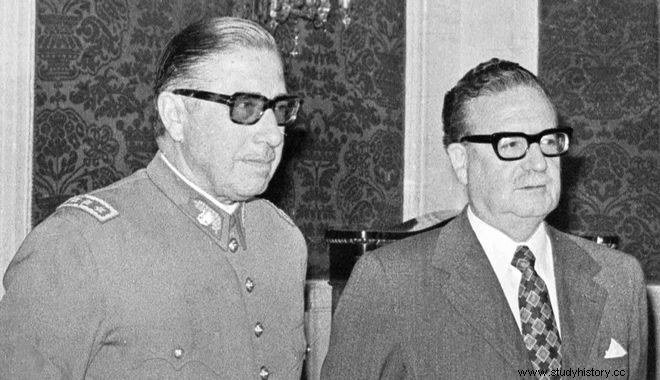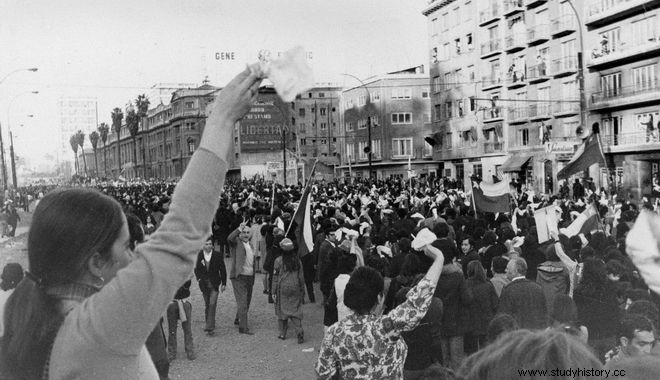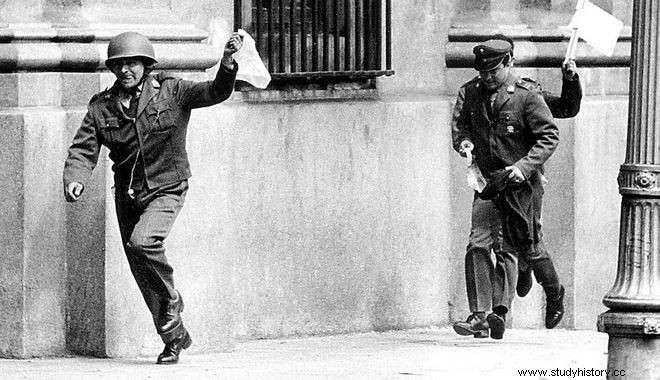For many, 9/11 is another "fluff", a "minor" episode that occurred on a date that was to change the course of world history:1973 is much more distant to younger people than 2001. The fall of the Twin Towers is a a more chilling image than any other shocking event that indelibly left its mark on the path of developments, be it the fall of the Berlin Wall or the fall of the Soviet Union.
But long before the events in New York, 9/11 had a different meaning, and the events in far away Chile had also moved in a different way and indeed almost instantly and instantaneously, despite the absence of the internet and social media at the time. . Then the world was shocked again as to how the "negative" force of History - then General Augusto Pinochet, like in 2001 the jihadists - could act so unperturbed in carrying out their austere deed.
Pinochet ordered and carried out the coup against the democratically elected progressive president Salvador Allende and established one of the bloodiest dictatorships, surviving for 17 years thanks to the lynchings, arbitrary arrests and disappearances of political opponents, torture and murder.
The then US president, Richard Nixon, his adviser, Henry Kissinger, and the CIA had just a week before, on September 4, passed on the plans to overthrow Allende, despite the State Department's opinion to the contrary. , as declassified US government documents reveal in 2008.
In the months following the coup, the National Stadium of Santiago became the macabre scene of the martyrdom and slaughter of an as yet unknown number of dissidents to the dictatorship. This episode still remains one of the darkest and most controversial events of the 20th century.
Immediately after Allende's election, Nixon ordered the CIA to "make Chile's economy cry" in order to undermine the reform plans of the new, unpopular in Washington, President:He begins the sabotage of large industrial companies, national and multinationals, blocking product transfers, favoring the flight of capital and investors and widening foreign debt.

At the same time, buckets of dollars continue to flow to Chile's Armed Forces, whose officers are traditionally trained at US military schools. In 1972 military aid is the only US funds entering the country. Washington is even blocking the renegotiation of Chile's debt. A plan that lasted three years.
On September 4, 1972, Allende, before the UN General Assembly, had denounced not only the aggression of the USA, but also the complete absence of control over the multinational companies, which were applying an economic stranglehold against his government:"We are in front of a real frontal conflict between to large multinational corporations and nation states. The latter are interfered in making and exercising their fundamental political, economic and military decisions by global organizations that do not depend on any state. For these activities, they are not accountable to any government nor are they subject to the control of any Parliament or institution that represents the common interest", the President of Chile had emphasized.
A year later, at 9:20 a.m. on September 11, 1973, Allende delivered what would be his last speech:"Long live Chile, long live the people, long live the workers... these are my heartfelt words and I am sure that my sacrifice will not be in vain. I am sure that, at least, it will be a moral lesson that will condemn perjury, cowardice and treason", Allende pointed out in the last and most dramatic of the five short messages he delivered to his people from the microphones of Radio Magallanes. The awareness that his end was coming was palpable in his voice, but he did not lack courage and the will to leave his people a legacy.
The circumstances under which Allende met his death have never been clarified. He was in the Presidential Palace of Moneda and according to the official version, he committed suicide with the Kalashnikov AK-47 that had been given to him by the Cuban leader, Fidel Castro, in order not to fall into the hands of the coup plotters. Others argue that he was killed by the coup plotters defending the Palace.

The efforts of the Chilean Right to exonerate Pinochet and his accomplices from all charges have never stopped and the country's society is still divided and the scars left by the Dictatorship remain alive. The difficulties of the current president Michelle Bachelet to manage this heavy legacy highlight how the events of that time have left deep traces in the country.
Many politicians who had taken office during the Dictatorship still have an active role in the political events of Chile. Like Pinochet's former Foreign Minister, Sergio Fernandez, Andres Chadwick, the dictator's Minister of the Interior, Sebastian Piñera, who as a young man participated in the Tsacharilia pogrom in 1977 - equivalent to the Nazis - to "save the country". And many more.
The efforts of the National Committee for Historical Memory are difficult. Because its aim collides with the deep roots that have spread an even more sinister plan, which found its application in Chile and spread to Argentina, Brazil, Bolivia, Paraguay and Uruguay. It was the Chicago Boys plan of ultra-conservative University of Chicago economics professor Milton Friedman to spread the neoliberal economic model, whatever the cost to the "subject" states. A plan spearheaded by the FBI and CIA to eliminate those who oppose it by any means necessary. In Chile, the implementation of this plan took the form of a struggle between the forces of reaction and the President elected by the people.
Pinochet's dictatorship was not simply designed to overthrow the progressive Allende. It was intended to serve as a "laboratory" for the implementation of a development model that could later be exported abroad. A true revolution of the production model in the context of the then emerging globalized capitalism. Through the neoliberal policy, which abolished every structure of social benefits and labor and social rights, the country modernized in order to serve the needs of foreign companies, into whose hands its production passed. This modernization is also the reason why when Pinochet left active politics in 1988, 43% of the country's inhabitants supported him. The Chicago Boys design is still practiced in many variations today. A recent example is the economic strangulation of Venezuela.
Allende's sacrifice, however, is still a symbol of struggle on the Latin American continent. It also reflects the example of the cost that a state in the region is asked to pay when it wants to follow its own experience for a short period of time, to apply its own example in governance and economy, to draw up an independent, democratic policy , without the interventions of the "big neighbor", Washington, which considers Latin America as its vital sphere of influence.

Many politicians who had taken office during the Dictatorship still have an active role in the political events of Chile. Like Pinochet's former foreign minister, Sergio Fernandez, Andres Chadwick, the dictator's interior minister, Sebastian Piñera, who as a young man took part in the Tzacharilia pogrom in 1977 - equivalent to the Nazis - to "save the country". And many more.
The efforts of the National Committee for Historical Memory are difficult. Because its aim collides with the deep roots that have spread an even more sinister plan, which found its application in Chile and spread to Argentina, Brazil, Bolivia, Paraguay and Uruguay. It was the Chicago Boys plan of ultra-conservative University of Chicago economics professor Milton Friedman to spread the neoliberal economic model, whatever the cost to the "subject" states. A plan spearheaded by the FBI and CIA to eliminate those who oppose it by any means necessary. In Chile, the implementation of this plan took the form of a struggle between the forces of reaction and the President elected by the people.
Pinochet's dictatorship was not simply designed to overthrow the progressive Allende. It was intended to serve as a "laboratory" for the implementation of a development model that could later be exported abroad. A true revolution of the production model in the context of the then emerging globalized capitalism. Through the neoliberal policy, which abolished every structure of social benefits and labor and social rights, the country modernized in order to serve the needs of foreign companies, into whose hands its production passed. This modernization is also the reason why when Pinochet left active politics in 1988, 43% of the country's inhabitants supported him. The Chicago Boys design is still practiced in many variations today. A recent example is the economic strangulation of Venezuela.
Allende's sacrifice, however, is still a symbol of struggle on the Latin American continent. It also reflects the example of the cost that a state in the region is asked to pay when it wants to follow its own experience for a short period of time, to apply its own example in governance and economy, to draw up an independent, democratic policy , without the interventions of the "big neighbor", Washington, which considers Latin America as its vital sphere of influence.
